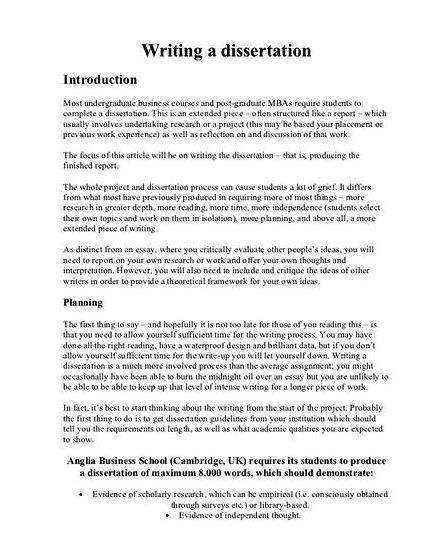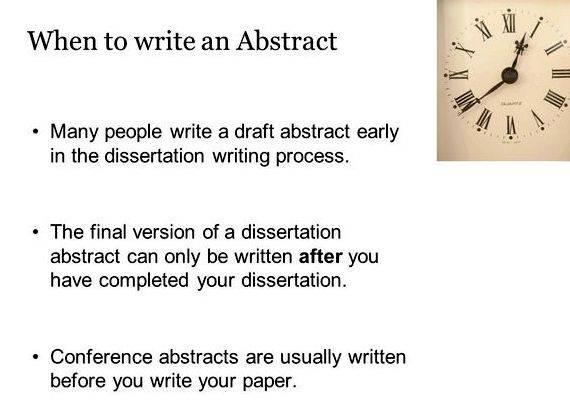Writing the Dissertation1
Introduction
By the time you start to write the first draft of your dissertation, you will probably already have accumulated a wealth of notes, scribbles and ideas. Planning is essential, but do not be hesitate to draw up new plans whether it is a brief abstract of your dissertation as a whole, or a detailed breakdown of a particular chapter. This section looks at effective planning, which should be a continuous process that intensifies during the writing of your dissertation and not something that fades into the background.
Do all dissertations look the same?
At one level, yes. They will have to:
- Formulate a clear question that your dissertation seeks to answer.
- Review the literature in the field relating to your question.
- Engage in independent research in addressing this question.
- Justify whatever methods you choose to undertake your research.
- Present and discuss your findings, whilst demonstrating how they relate to your original question.
Watch Different types of dissertations video (.wmv)
Do all dissertations look the same? This video clip contains comments from the following academics:
- Kevin Bonnett
- Malcolm Todd
Sociology - Shawna McCoy
Criminology - Christopher Christopher-Dowey
Criminology
Producing a ‘working title’
Insofar as the preparation of the dissertation is a process of investigation and discovery, the precise scope of your study may well only emerge as you become closely involved in a detailed review of the literature. At this early stage, your title may be a provisional one that you will revise later. Your dissertation supervisor may advise on the title in order to help you find and define the focus of the dissertation.
You should examine articles in scholarly journals for examples of appropriate titles for a study of this length.
Starting to write the dissertation
Supervisors have different ways of working and you will, to some degree, need to negotiate your approach to supervision style. For example, your supervisor may advise you to write a short proposal or abstract, say of about 300 words, in which you set out as clearly as possible what you intend to do in the dissertation. The value of this exercise is that it requires you to focus and articulate your thinking. It may be that you will be able to summarise the exact nature and scope of your study, in which case the proposal can serve as guide to refer to as you write the main chapters of the work. Alternatively, it may make you aware of gaps in your knowledge and understanding, and show you the areas that need further thought and research.
It is useful, therefore, to write the proposal and to retain it for reference and revision. It helps to attempt such an abstract even if your supervisor has not suggested that you write one. However, practice varies, and your supervisor will advise you on how to proceed. As you continue to write the main chapters of the work, you may find that your initial plan has changed. This means that when you have completed the chapters that form the main body of your dissertation you can return to the proposal and revise it as much as you need, to form the introduction.
It is highly advisable to draft a plan of the dissertation.
There is a lot in common between different dissertations regarding the structure and although you do not need to stick slavishly to a standard plan, such a plan is very helpful as a template to impose some order on what may seem an unmanageable task. Here is an indicative structure that might help you with your initial plan.
An overall assessment of what you found out, how successful you were and suggestions for future research.
Beginning work on the main body of the dissertation
Once you have produced the proposal and discussed it with your supervisor, you may want to write the first draft of a chapter of the dissertation. When you hand in this draft, you should arrange a tutorial to receive your supervisor’s verbal or written comments and suggestions on how it may be improved. You may, for example, produce a draft introduction setting out the issue, together with a literature review which covers what, if any, treatment of the topic has gone beforehand. You may also wish to draft those sections of the methodology chapter that cover the methods that you wish to use, together with a justification for why you think those methods are best.
Revising sections after receiving the supervisor’s comments
When you have received your supervisor’s comments on the draft of any chapter, you should revise that particular chapter immediately. Prompt revision is easier than letting things drift, and you should do it while the advice of your supervisor is fresh in your mind. This will also avoid building up a backlog of work that needs to be revised, which can be discouraging. Having the material on a computer disk will enable you to do revisions efficiently and with a minimum of fuss. Be sure to back up all your work on a floppy disk, CD, or memory stick.
Organising your time
Depending on the credit rating of the dissertation, the amount of time you devote to it should be equivalent to the time you would devote to a taught course with the same credit rating; that is, seminar and lecture time plus time for private study.
Findings from our Research
In our research we found that students often did not think about the credit rating of their dissertation and actually spent more time working on it than they should have! They saw it as such an important part of their degree that they wanted to put more into it:
It [the dissertation] took up more of my time. Once you get into it, you have to out in the effort. It’s 8000 words, plus there’s so much to do. When you’re doing it, it seems so much more that the rest of your work (Todd, Bannister and Clegg, 2004, p341).
However, this can have a detrimental effect on your other modules – one student said ‘I did the dissertation and left the other work’ – don’t make his mistake. All the modules in the final year are important.
You will find that once the final year begins, the weeks go by very quickly, and you will need to organise your time well from the start so that the ongoing preparation of your dissertation continues alongside work for the taught units you are studying. Once you have a workable plan it is much easier to plan the work in sequence and to set yourself targets for the completion of the separate parts (see the section on Getting started with the Dissertation). Allow plenty of time for final revisions after your tutor has seen a complete draft.
If you are taking a dissertation over two semesters, you should aim to spend the equivalent of one full half-day per week working on your dissertation during each semester of your final year if it is worth 20 credits – nearer twice that amount of time if it is a 40-credit dissertation.
Deadlines for producing drafts
You will decide with your supervisor precisely when to produce drafts, but if you are taking a dissertation module over one academic year then by the end of the first semester you would normally expect to produce a proposal or abstract and a first draft of one or two chapters. You would then produce the drafts of the remaining chapters and complete the process of revision and writing-up during the second semester.
In the second semester, when drafting the remaining main chapters of the dissertation, you will follow the practice established in the first semester of submitting the drafts to your supervisor for comments and advice. You should take advantage of the period between the first semester and the start of the second semester to write a draft of a chapter, and you should plan to have produced first drafts of all the main chapters by at least four weeks before the submission date (also allowing for any vacation periods when staff may not be available).
If, however, you are taking the dissertation module over one semester, you will need to adjust this time frame accordingly.
Writing the introduction
The introduction to your dissertation should explain to the reader what you are going to investigate. It should describe the dissertation’s topic and scope. You should explain your reasons for investigating your chosen topic by referring to the appropriate literature. Having completed the work on the main substance of your dissertation, you should have a much clearer idea of its nature and scope than you did when you wrote your preliminary abstract or proposal. The introduction to your dissertation should explain to the reader what you are going to investigate. It should describe the dissertation’s topic and scope. You should explain your reasons for investigating your chosen topic by referring to the appropriate literature.
It is important, however, to write the introduction as though you are setting out on a process of investigation. You need to emphasise the exploratory nature of your work. You should also avoid anticipating the discoveries and conclusions that you have made in the course of your investigations. So, you might simply say that you have identified certain common features in the relevant literature, or a particular issue that it deals with, and that your dissertation will examine the literature closely in order to demonstrate the relationships between treatments of the issue in the sample texts. When you have completed the main body of the work and your tutor has commented on your complete draft, you may well wish to revisit the introduction to take into account your findings and your tutor’s comments on their significance.
Writing a literature review
Your dissertation is a substantial piece of written work that ideally should conform to a number of academic conventions. One of the most important of these academic conventions is the literature review. In short, the literature review is a discussion or ‘review’ of secondary literature that is of general and central relevance to the particular area under investigation.
Often students ask how long a literature review should be. This is a difficult question given that the total length of your dissertation might be anything from five to twelve thousand words. Obviously your supervisor may be able to give some indication of the approximate length of your literature review. However, don’t become pre-occupied with word length, the main thing is that your literature review should capture the general and specific aspects of the literature of your subject.
Why is a literature review necessary?
The literature review is an important device in your dissertation as it performs a number of related functions:
- It demonstrates to whoever reads the dissertation that the author of the work has read widely and is aware of the range of debates that have taken place within the given field. It provides the proof that you have more than a good grasp of the breadth and depth of the topic of the dissertation – your dissertation gives you the opportunity to show off how clever you are! The literature review is a great place to start, because it should demonstrate that you know what you are talking about because you have read everything that is relevant to your dissertation.
- It can provide the rationale for the research question in the study. This can be done by highlighting specific gaps in the literature – questions that have not been answered (or even asked), and areas of research that have not been conducted within your chosen field. In this way the literature review can provide a justification of your own research.
- It can allow you to build on work that has already been conducted. For example you might adopt a similar methodological or theoretical approach in your work to one that exists within the literature, yet place your actual emphasis elsewhere. In this way you are building on work that has already been conducted by adopting similar strategies and concepts, yet focusing the question on something that interests you.
- It helps to define the broad context of your study, placing your work within a well defined academic tradition. Poor dissertations often fail to relate to broader debates within the academic community. They may have a well defined research question, yet without placing this question in the appropriate context, it can lose its significance. The literature review therefore can add weight to your question by framing it within broader debates within the academic community.
How do I ‘do’ a literature review?
Writing a literature review is not as simple as at first it may seem. What follows is a step by step guide on how to go about conducting and presenting your literature review.
The first stage of your literature review is to collect a list of literature that is relevant to your study. You have already seen in the section Help with Finding Literature and Research how you can get a list of useful references.
Once you have a list of references for your dissertation, you now have to access and read this material. This is time consuming because you will be reading a large amount of material. Once you start you might find that some literature is of little relevance to your study. This is something that many researchers and dissertation students go through and is often a necessary part of the process. It is better to read something that is not central to your dissertation than miss something that might be an important and relevant contribution to the field.
Make notes about the central themes and arguments of the book, chapter or article. These notes can then be incorporated into the finished version of your literature review. Try and get a sense of the theoretical perspective of the author, this will be of use when you organise and present your literature review. Also, emphasise the way in which the piece of literature you are reading seeks to set itself apart from other literature. Importantly, start to think critically about the piece you are reading; ask: what is this person trying to say and why? How is it different from the way others have dealt with this issue? This critical component is very important as it demonstrates that you are engaging with relevant literature in an appropriate manner and that you can discriminate between different perspectives and approaches that exist within your chosen field.
Once you have generated a large number of notes around your reading you might start to feel overwhelmed by the literature. In terms of the organisation and presentation of your literature review, it is worth dividing your review into two main areas: general reading and literature that is of central importance. You will also need to further divide the literature into specific areas relevant to your study for e.g. theories and concepts; policy analysis; empirical studies and so-on. What follows are some general guidelines on how you might do this.
General texts
It will be clear that some of the reading you have done is of more relevance than others. It is important, however, that you do not discard the less relevant work; instead this can form the broad background of your discussion of the more relevant literature within your field. For example you may mention different authors that have dealt with a question related to your field but may not be central to it. Highlight these in broad terms, state how these works have impacted on your particular area. You need not go into great detail about these more general works, but by highlighting these works you are demonstrating your awareness of the scope and limits of your study and how it touches upon other areas of study.
Central texts
Once you have discussed the range of literature that is only of general interest to your study, you can then go into more detail on the literature that more sharply focuses on the questions that are of interest to you. Devote more detail to these particular works as they are more important to your topic. Indeed they may highlight the gap in the literature that exists that you seek to fill; they may provide the basis on which you seek to build, or they might be works which require some critique from your particular perspective.
Further categorisation
When you have divided your literature review into general works and works of central importance, you should also further divide the literature into sub-categories. By further dividing your literature in this way, you are adding more organisation into your literature review by providing specific sub-categories of relevant literature.
For example in the general works section of your literature review, you might want one sub-heading on the main theoretical debates, one on empirical studies and maybe one on policy. With reference to the more central literature, you could organise this more important reading in a similar way. For example, if relevant, you could have a section on competing theoretical perspectives; a section on the main findings of important empirical studies; a section on policy implementation and its impacts. See the table below.
Breakdown of Literature Review






 University of ottawa electronic thesis and dissertation
University of ottawa electronic thesis and dissertation Loi des douze tables dissertation writing
Loi des douze tables dissertation writing Online the ses and dissertations on bullying
Online the ses and dissertations on bullying Letter to phd dissertation committee
Letter to phd dissertation committee Case study based dissertation proposal
Case study based dissertation proposal






